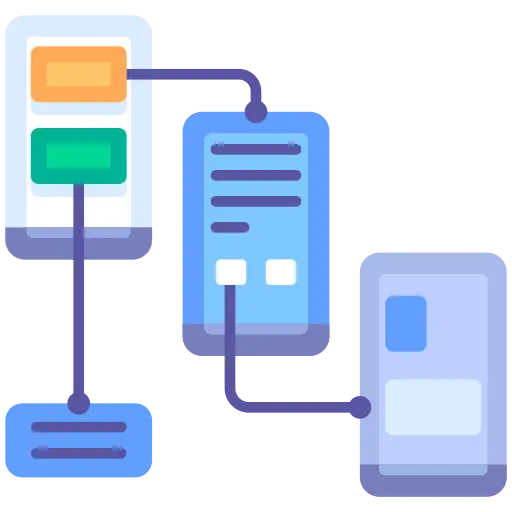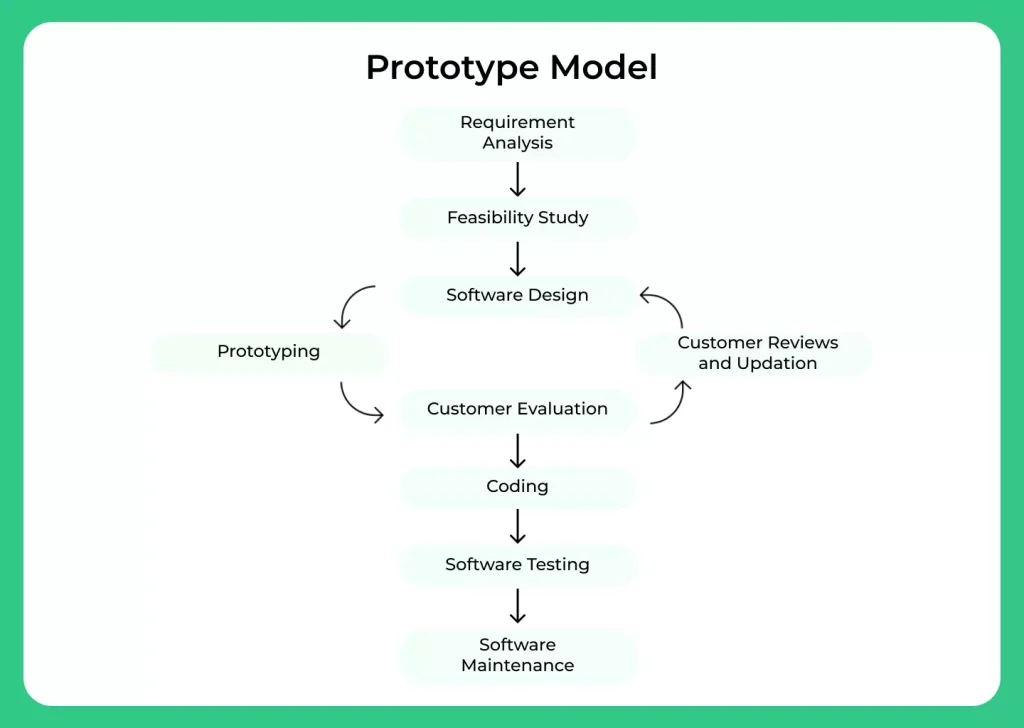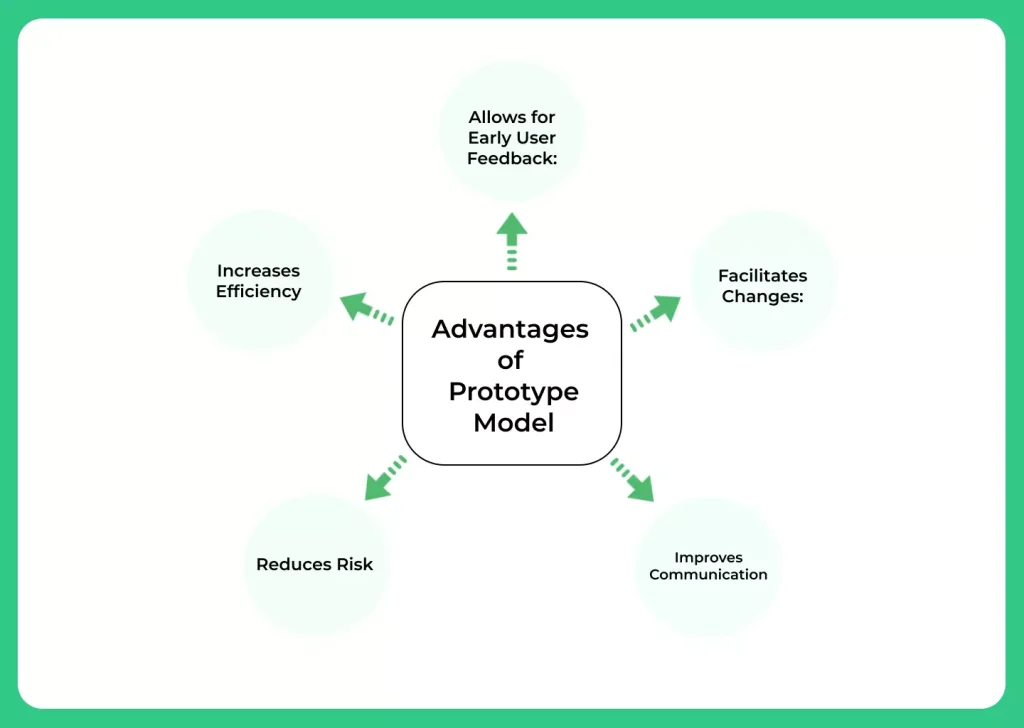Prototype Model in SDLC
What is Prototype Model in SDLC?
The prototype model is a software development life cycle (SDLC) model in which a prototype is built, tested, and then reworked as necessary until an acceptable prototype is finally achieved from which the complete system or product can be developed. The prototype model is an iterative process that begins with the creation of a preliminary version of the software, which is then tested and refined until it meets the requirements of the user.

Processes followed in Prototype Model


There are several steps involved in creating a prototype model:
Define the problem:
Clearly define the problem you are trying to solve and the objectives of your prototype model.
Gather data:
Collect and organise the data that you will need to train your model. This may involve scraping websites, collecting data from APIs, or gathering data from other sources.
Clean and preprocess data:
Clean and preprocess the data to remove any errors or inconsistencies. This may involve filling in missing values, converting data into a usable format, or removing outliers.
Split data into training and test sets:
Split the data into a training set and a test set. The training set will be used to train the model, while the test set will be used to evaluate the model’s performance.
Choose a model:
Select the type of model that you will use to solve the problem. There are many different types of models to choose from, including linear regression, logistic regression, and neural networks.
Train the model:
Use the training set to train the model. This may involve adjusting the model’s parameters and fine-tuning its performance.
Evaluate the model:
Use the test set to evaluate the model’s performance. This may involve calculating metrics such as accuracy, precision, and recall.
Iterate and improve:
Based on the model’s performance, you may need to go back and make improvements to the model. This may involve gathering more data, selecting a different model, or adjusting the model’s parameters.
Deploy the model:
Once the model is performing well, you can deploy it in a production environment to solve the problem you defined in step 1.
Types of Prototype Model in SDLC
In the Software Development Life Cycle (SDLC), a prototype model in software engineering is like a rough draft or a working model of the software before the actual product is built. The prototype model in software engineering is used to understand how the final product might look and work, allowing developers and users to explore ideas and spot issues early on.
Here are the common types of prototype models in SDLC:
Throwaway/Rapid Prototyping:
- This is a quick, rough model created to understand the user’s requirements.
- Why It’s Used: It’s useful for getting immediate feedback from users. Once the feedback is received, the prototype is discarded (“thrown away”) and not used in the final product.
Evolutionary Prototyping:
- This type of prototype is built and improved over time. The initial version is simple, and new features are added gradually based on user feedback.
- Why It’s Used: It’s beneficial when the final requirements are not clear from the start, allowing the software to evolve as new needs are discovered.
Incremental Prototyping:
- In this approach, different parts of the software are developed and tested as separate prototypes. Later, these parts are combined to form the complete system.
- Why It’s Used: This helps in managing complex systems by breaking them down into smaller, manageable parts.
Extreme Prototyping:
- Mainly used in web development, this method involves three phases—creating a basic prototype with all pages, then adding the logic and functionality, and finally integrating all parts.
- Why It’s Used: It allows for a quick build and testing of web applications, ensuring that the final product works well across different platforms.
Operational Prototyping:
- This prototype is very close to the final product and can be used for initial operations. It’s like a working version of the software that may need only minor changes before final release.
- Why It’s Used: It’s ideal for scenarios where the prototype is almost as good as the final product and can be used to gather feedback from real users.
Prime Course Trailer
Related Banners
Advantages of Prototype Model in SDLC:
This model is particularly useful when the requirements of the final product are not well-defined, or when the product is expected to undergo significant changes during the development process.
There are several advantages to using the prototype model in the SDLC:
- It allows the development team to quickly create a working model of the product, which can be tested and evaluated by the users.
- It enables the development team to gather feedback from the users, which can be used to improve the design and functionality of the final product.
- It allows the development team to focus on specific aspects of the product, rather than trying to build the entire product at once.
- It allows for a more flexible and iterative development process, as the prototype can be modified and improved based on the findings from each iteration.
- It can help to reduce the overall cost of the project, as the prototype can be developed and tested with minimal resources.


Disadvantages of Prototype Model in SDLC
There are several disadvantages to using the prototype model in the software development life cycle (SDLC):
- It may not be suitable for large and complex projects, as the prototype may not scale well and may require a significant amount of rework to turn it into the final product.
- It can be time-consuming and costly to create multiple prototypes and revise them based on user feedback.
- The prototype may not accurately represent the final product, leading to misunderstandings and unrealistic expectations from users.
- The prototype may not adequately address all functional and non-functional requirements of the final product.
- There is a risk of the prototype being discarded or significantly revised during the development process, leading to wasted effort and resources.
- It can be difficult to accurately estimate the cost and timeline for a project using the prototype model, as the scope may change significantly during the development process.
In Summary
The prototype model in software engineering offers a flexible and interactive approach to software development by emphasizing early user involvement and continuous feedback. It allows developers to create a working prototype quickly, which helps clarify requirements and minimize misunderstandings.
With its iterative nature, the prototype model in software engineering is ideal for projects with evolving needs or unclear specifications. It enhances client-developer communication, reduces rework, and ensures the final product closely aligns with user expectations.
FAQs
It allows early visualization of the system, helping users and developers understand and refine requirements. This reduces the risk of costly changes later.
It improves user involvement and helps uncover missing or unclear requirements. This leads to better system understanding and reduced development risks.
It’s ideal when requirements are not clearly understood or are expected to evolve. It suits projects with high user interaction and complex functionality.
Get over 200+ course One Subscription
Courses like AI/ML, Cloud Computing, Ethical Hacking, C, C++, Java, Python, DSA (All Languages), Competitive Coding (All Languages), TCS, Infosys, Wipro, Amazon, DBMS, SQL and others



Login/Signup to comment